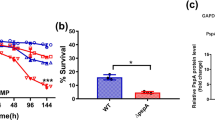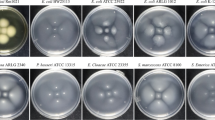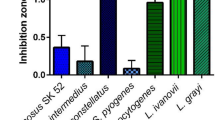Abstract
IT has been generally believed that penicillins act on Gram-negative bacilli by interfering with cell wall synthesis leading to the release of spheroplasts which then succumb to osmotic damage. Such damage is usually fatal although in conditions of suitably high osmolarity the spheroplast phenomenon is known to be reversible1. Using turbidimetric methods supported by morphological studies in the scanning electron microscope, we have recently demonstrated that Escherichia coli and Proteus mirabilis show a variety of responses to penicillins which cannot be satisfactorily explained on the basis simply of the emergence and subsequent osmotic destruction of spheroplasts2,3. With the high bacterial population densities used, large numbers of “persisters” (organisms which survive exposure to bactericidal concentrations of penicillin although their progeny remain fully sensitive4) could be recovered after prolonged exposure to penicillins, and it seemed that this survival resulted from yet another response to the agents. In this investigation we have extended our studies and have attempted to elucidate the persister phenomenon.
This is a preview of subscription content, access via your institution
Access options
Subscribe to this journal
Receive 51 print issues and online access
$199.00 per year
only $3.90 per issue
Buy this article
- Purchase on Springer Link
- Instant access to full article PDF
Prices may be subject to local taxes which are calculated during checkout
Similar content being viewed by others
References
Lederberg, J., Proc. US Nat. Acad. Sci., 42, 574 (1956).
Greenwood, D., and O'Grady, F., J. Med. Microbiol., 2, 435 (1969).
Greenwood, D., and O'Grady, F., J. Infect. Dis. (in the press).
Bigger, J. W., Lancet, ii, 497 (1944).
Watson, B. W., Gauci, C. L., Blache, L., and O'Grady, F., Phys. Med. Biol., 14, 555 (1969).
Taubeneck, U., Nature, 196, 195 (1962).
Guze, L. B., and Kalmanson, G. M., Science, 143, 1340 (1964).
Gunnison, J. B., Fraher, M. A., and Jawetz, E., J. Gen. Microbiol., 35, 335 (1964).
Kalmanson, G. M., Hubert, E. G., Montgomerie, J. Z., and Guze, L. B., Antimicrobial Agents and Chemotherapy, 304 (Amer. Soc. Microbiol., 1967).
Author information
Authors and Affiliations
Rights and permissions
About this article
Cite this article
GREENWOOD, D., O'GRADY, F. Trimodal Response of Escherichia coli and Proteus mirabilis to Penicillins. Nature 228, 457–458 (1970). https://doi.org/10.1038/228457a0
Received:
Revised:
Issue Date:
DOI: https://doi.org/10.1038/228457a0
Comments
By submitting a comment you agree to abide by our Terms and Community Guidelines. If you find something abusive or that does not comply with our terms or guidelines please flag it as inappropriate.



